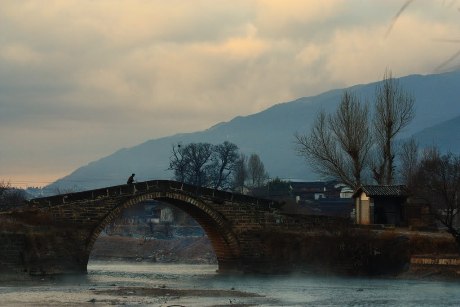In ancient China, it was fashionable among the gentry to escape the hurley-burley of court life and find solace among the mountains; to watch the shape-shifting clouds pass across the sky, observe immutable mountain peaks and forget the struggles of daily life.
These days, nature tourism remains as popular as ever in China. Travel to the mountains of China’s southwest Yunnan province and you will find yourself elbow to nose with thousands of other companions seeking respite from the oppressive summer heat of the cities. Yunnan, a vast melting pot of different cultures, plants and animals, now attracts millions of Chinese and foreign tourists every year. Clouds of screeching loud speakers and tour groups sporting matching baseball caps now compete for space upon craggy peaks. Popular scenic towns like Lijiang and Dali, have been consumed by now groan under the sheer volume of visitors and their modern accoutrements – Starbucks, KFC and Karaoke.
But some places have had a softer awakening. Shaxi, an ethnic Bai village nestled deep in the Himalayan foothills is my favourite place in China for quiet contemplation. Here the disconsolate traveller can catch a rare glimpse into rural Chinese life. There is not much to do in Shaxi, which is part of its charm – a perfect place to sip tea, eat wild mushrooms, wonder the cobbled-stone alleys, follow the streams that run through the village, and chat about this and that with passers-by.
Shaxi was once a bustling market town on the ancient tea and horse road, a centuries old trade route that connected China and Tibet – and an important part of the Silk Road. In exchange for tea from Yunnan, Tibetans traded their famous breed of horse to the Chinese, who were busy defending their territory from barbarian invaders in the north – antecedents of Genghis Khan’s hordes.
But over the years, trade diminished until it stopped completely in the 1950s. Shaxi became quiet and forgotten, its architecture decaying to the point of collapse. In 2001, a Swiss architect, Jacques Feiner, travelled through the area. A conservation expert with the Swiss Federal Institute of Technology Zürich, Feiner worked with the local government to restore some of the beautiful Bai houses, temples and other structures.
The Shaxi rehabilitation project has not only restored buildings, the team has also emphasised cultural preservation and developed a plan for sustainable tourism and development of the entire valley. They have improved family houses, built sanitation and waste-treatment systems, eco-toilets, upgraded electricity lines and explored economic opportunities for local people, such as eco-tourism and organic farming.
No glitzy hotels have been built, just guest houses run by local residents. And so, while other ancient town along the tea horse road have been consumed by the tourist trade, local minority residents moved out and replaced by Han Chinese business people, Shaxi’s tourist trickle has been largely community-led.
So far Shaxi has been protected from mass tourism due to it relative remoteness. But some people fear that this will all change when, in 2014, a new main road will connect Shaxi to Yunnan’s package tour favourites, Lijiang and Dali; and despite all efforts to develop sustainable tourism, the charm of the valley will be buried under the wheels of tour group coaches, modern tiled blocks and faceless development.
The third pole team hotly debated whether or not to share the secrets of Shaxi with our readers. But one by one we have made our own pilgrimage to Shaxi, and in the end our enthusiasm for the place overcame our desire to keep it to ourselves. Here is a selection of photos showing some of the peaceful delights of Shaxi. We hope you enjoy.
Beth Walker is UK editor of thethirdpole.net.
Photos by Joe Orton, Meng Si, Joshua Cohen and Beth Walker.

